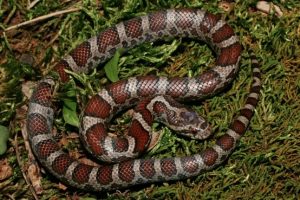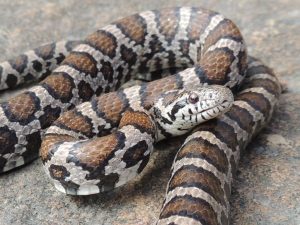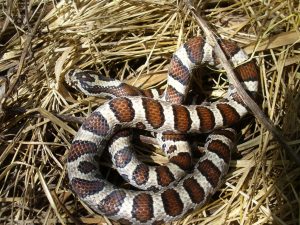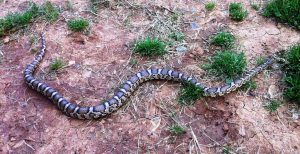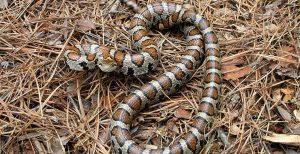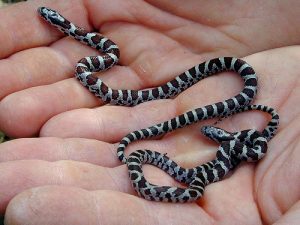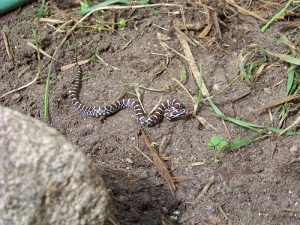Eastern Milk Snake
The eastern milk snake is a non-venomous subspecies of milksnake. The calm snake is a popular name in the pet trade.
Scientific Name
| Kingdom | Animalia |
| Phylum | Chordata |
| Class | Reptilia |
| Order | Squamata |
| Suborder | Serpentes |
| Family | Colubridae |
| Genus | Lampropeltis |
| Species | L. triangulum |
| Scientific Name | Lampropeltis triangulum triangulum |
Quick Information
| Also Known as | Spotted adder, adder, sand-king, thunder-and-lightning snake, milk sucker, leopard-spotted snake, checkered snake, cow-sucker, chicken snake, checkered adder, chain snake, king snake, pilot, red snake, sachem snake, highland adder, horn snake, common milk snake, blatschich schlange, king snake, house snake, scarlet milk snake, and milk sucker, |
| Description | Size: 24-26 in (60-91 cm) Color: The dorsal saddle is reddish brown or simply red, brown blotches with black borders on the sides and top. The belly has a checkered pattern in gray and black. Juveniles exhibit blotches in intense red shades |
| Distribution | North Carolina to Alabama, Ontario to Maine |
| Habitat | Meadows, woodlands, pastures, and near water streams |
| Lifespan | 10-12 years in the wild; up to 20 years in the captivity |
| Diet | Mice, earthworms, insects, frogs, non-venomous eastern garter snakes, and small birds |
| Predators | Raccoons, skunks, and opossums |
Behavior
- The snake has a docile deportment and typically won’t become aggressive unless threatened.
- The snake constricts its prey until they suffocate to death.
Mating & Reproduction
From late April to May (spring season), the snakes mate. Being an oviparous species, the female snake lays 4-18 eggs either in June or July. Eggs are creamy-white in color, often laid inside deep burrows.
Life-cycle
Hatchlings emerge from the eggs around September, each sizing 4-8 inches. They have an egg tooth that helps them break the hard exterior of the egg. Their sexual maturity is attained at the age of 3 or 4 years.
Interesting Facts
- The species is once thought to be an intergrade (meaning sharing the same locality with another species, and having some common physical attributes) with scarlet kingsnake, but the theory doesn’t stand anywhere.
References
- https://www.virginiaherpetologicalsociety.com/reptiles/snakes/eastern-milksnake/index.php
- https://reptilesmagazine.com/listings/snakes-care-sheets/eastern-milk-snake/
- http://herpsofnc.org/eastern-milksnake/
- https://kysnakes.ca.uky.edu/snake/lampropeltis-triangulum
- https://www.maine.gov/ifw/fish-wildlife/wildlife/species-information/reptiles-amphibians/eastern-milksnake.html
- http://wildlifeofct.com/eastern%20milksnake.html
Published on June 25th 2019 by Sahana Kanjilal under Coniferous Forest Animals.
Article was last reviewed on 5th December 2024.


